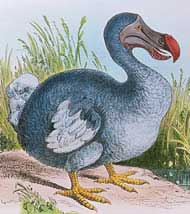Articles and reports from the Life Sciences and chemistry area deal with applied and basic research into modern biology, chemistry and human medicine.
Valuable information can be found on a range of life sciences fields including bacteriology, biochemistry, bionics, bioinformatics, biophysics, biotechnology, genetics, geobotany, human biology, marine biology, microbiology, molecular biology, cellular biology, zoology, bioinorganic chemistry, microchemistry and environmental chemistry.

Ancestors of the flightless figurehead of extinction island-hopped.
The flightless dodo’s ungainly shape hid an island-hopping past, say researchers. DNA from the extinct bird has revealed its place in the pigeon family tree, and suggests how it came to end up on its home, and graveyard, the island of Mauritius 1 .
The dodo’s strange appearance led to centuries of wrangling over its ancestry. “It’s the figurehead of extinction, yet little is known about its e

The reindeer`s antlers make the beauty and the pride of a male, being a reliable weapon during spring tournaments. In autumn the antlers are no longer needed, so reindeers shed the antlers and grow them up anew in the next season. With the majority of the reindeer types, the male sex hormones control the growth of the antlers. But the reindeer`s doe has also got antlers. A pregnant doe carries antlers throughout winter, as the antlers help a doe to get food from under the snow, to keep off predators

New technique could help rapid detection of infecting organisms in hospitals and prove authenticity of foods such
Researchers at the University of Wales, Aberystwyth (UWA) are about to put ultra-violet Raman spectroscopy through its paces as a new technique for studying biological materials.
Dr Roy Goodacre and colleagues in the Institute of Biological Sciences have been awarded a grant worth £306,291 by the Engineering and Physical Sciences Research Council (EPSRC) to develop an

Researchers from the Basque University have discovered the relationship between E2F2 gene and autoimmunity. The Science Faculty team, leaded by Ana Zubiaga has published the results of its researches in the fifteenth issue of the Immunity magazine.
The team began analysing E2F2 gene and its family. This gene family is responsible for the cell proliferation and the aim of the research was to discover how they work. There are 6 genes on this family and experts do not know yet the reason why

A Commission survey on the patenting and publication by EU scientists and organisations from industry and academia involved in biotechnology and genetic engineering research, that highlights the need for support to and training of academics in the proper use of the patent system. Public research organisations can handle patent applications almost as professionally as industrial organisations and without significantly delaying the publication of results that are subject to patent applications. In cont

Scientists at the University of Sussex have provided the key to resolving a 30-year-old controversy in evolutionary biology: what proportion of the differences between similar species came about as a result of natural selection, and how many are just the result of ‘random genetic drift’. In a paper in this week’s issue of Nature (28 February), Sussex biologists put the ratio at 45:55.
The DNA sequences of humans and chimpanzees differ by less than 2% but this adds up to about 350,000 amino a